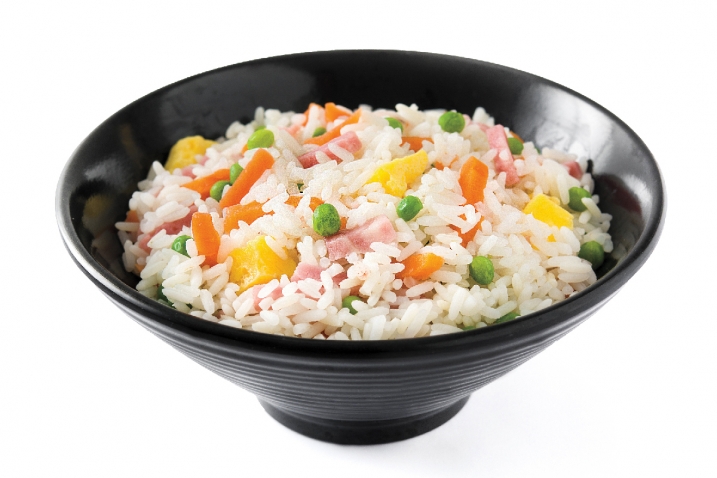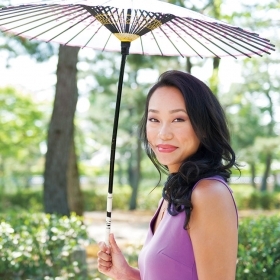I’ll remember this time by the fried rice. In the months I’ve spent sequestered at home, I’ve ransacked my pantry to make every iteration. When my shelves are full, the mixtures of kimchi and bacon, or crab paste and lap cheong sausage, are indulgent. When my reserves are lean, it might just be soy sauce and Spam. I’ve dabbled in a combination of greens, herbs, and lemon, inspired by a trip to Greece; I’ve crisped rice in olive oil and added za’atar. In every format, fried rice is comforting, especially if it’s finished with an egg.
The formula for fried rice is a loose one. If I’m using bacon, Spam, or Chinese sausage, I cook them first, because letting their fat render out feels resourceful. Then, as with all good things, I toast garlic, ginger, and the white bottoms of scallions until they’re warm and fragrant. Vegetables—whatever lingers in weird segments in the fridge—go in next, sizzled until they pick up color. To that, I add the rice and seasonings, which is where the process becomes more fun.
Having to cook nearly every single meal now, part of the appeal of fried rice is its flexibility. When my pantry is well-stocked, it’s full of glass bottles of soy sauce, sriracha, sesame and chili oils, cooking wine, and different vinegars. Used interchangeably, these all make fried rice taste good, but the day isn’t lost if my supplies are slim—salt, pepper, and a sprinkle of sugar, as odd as it might sound, go a long way.
I reach for whatever feels like the whim of the day. On the challenging days of housebound life, adding more sriracha might feel like a fiery extension of my bad mood, while more carefree days might call for a fried rice that’s similarly simple. After I add my sauces and pastes, the flavorful bottles and jars like little pick-me-ups, all I need to do is toss everything together in the pan. I don’t think I’ve ever made exactly the same rice twice, and it’s endlessly adaptable, just as I must remind myself to be.
At that point, in less than 20 minutes, I’m basically done. I can scramble an egg into the hot rice, letting it coat the grains as they might do at a Chinese restaurant, or if I don’t mind the extra dish, I might fry an egg and slide it on top. I might toss on a dash of scallion greens, a pinch of sesame seeds, a shake of furikake, or a spoonful of spicy chili crisp—or maybe even all of the above. This rice could be a side dish, but more often, it’s the whole meal.
While most elements of fried rice are flexible, one is strict: The rice must have at least a night’s sleep before it’s used, and be stored in the fridge. This is crucial for drying the rice out and keeps the grains from turning to mush when they’re tossed and fried. Leftover rice also works, but for me the value lies in making a batch of rice that is intended to be fried at a later time.
Fried rice is a dish that benefits from foresight, and during quarantine, this is perhaps why I’ve found so much comfort in it: Fried rice gives me something to look forward to, even if it’s just 12 hours ahead.
As the pandemic causes the fibers of our normal lives to unravel, this time can feel like an “infinite present,” as the New Yorker’s Helen Rosner has put it. Every day feels like a repeat of the one before, and for many of us, there are no longer weekend trips or family vacations to make the future palpable.
I’ve always been the type of person who eats while thinking about my next meal. It’s an excitement about eating that could be called a preoccupation, but in these not-so-normal times, that mindset feels like a gift. The events that made living in New York City worthwhile are all paused, the visits with college friends that I had planned for the summer were all canceled, and the days I spend working in digital media are a tortuous exercise in dealing with uncertainty. But when life one week from now feels too unclear, looking one meal ahead gives my next few hours purpose.
Spending 20 minutes frying rice doesn’t change very much about an individual day, but the process of preparing for it—of setting something up for myself, a day from now—gives me a much-needed sense of structure. It’s a reminder that no day is truly infinite, even if it might feel that way. Though I don’t know what a month from now might look like, I can guarantee at least something about tomorrow: a warm bowl of comforting rice.
Bettina Makalintal ’14 is a food writer who is cooking her way through the pandemic and wrote this essay as she was on lockdown in her 800-square-foot apartment in Brooklyn.








We ask that those who engage in Wellesley magazine's online community act with honesty, integrity, and respect. (Remember the honor code, alums?) We reserve the right to remove comments by impersonators or comments that are not civil and relevant to the subject at hand. By posting here, you are permitting Wellesley magazine to edit and republish your comment in all media. Please remember that all posts are public.